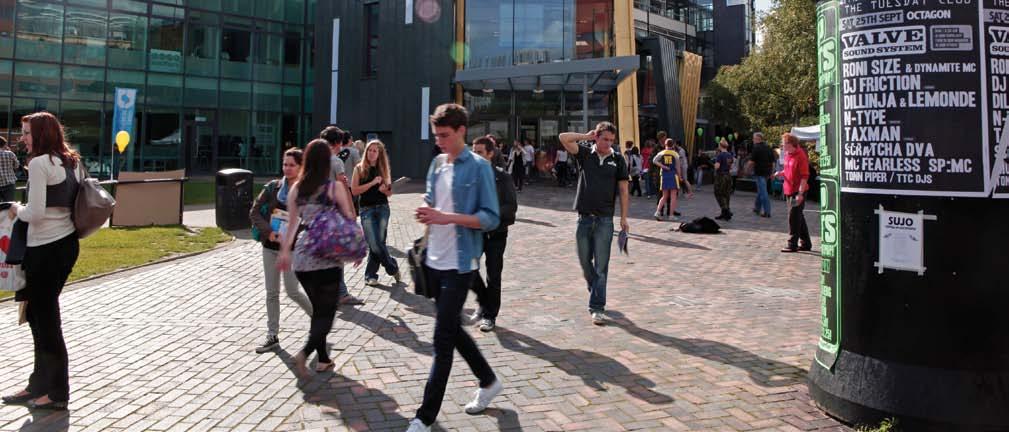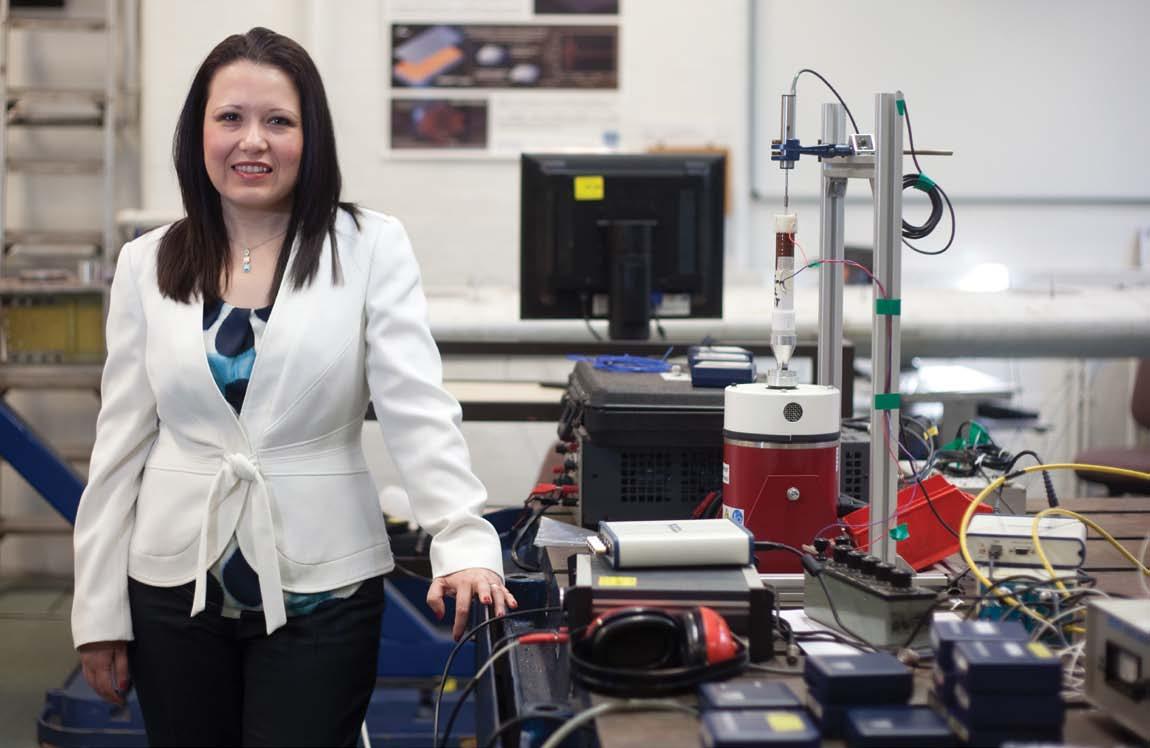
18 minute read
Kaleidoscope
Exploring the diverse group of people associated with the University of Sheffield
Elena Rodriguez-Falcon
Advertisement
Enterprising engineer
“When I stood in fro nt of a grou p of stude nts
for the first time, something clicked,” said Elena Rodriguez-Falcon (PgDip Teaching and Learning for University Lecturers 2007). “It was an exciting feeling, a passion I hadn’t felt before. I fell in love with teaching.” This experience drove Elena on to become a passionate advocate for developing new methods of teaching engineering students. She is now Director of Enterprise Education for the University, as well as a Senior University Teacher in Mechanical Engineering and Faculty Director of Women in Engineering.
Following seven years in industrial management, Elena came to Sheffield from her native Mexico in 1999, to take an MBA Industrial Management at Sheffield Hallam University. “My first impression was that the city was quite peculiar,” she explained. “I arrived on a Sunday and all the shops were closed. Everything was so quiet! But it didn’t take long for me to become immersed in the culture and I loved it. I don’t want to live anywhere else in the UK. Mexicans are very patriotic people and I never thought I’d feel like this about anywhere else.”
Having completed her MBA, Elena applied for a job in the Department of Mechanical Engineering “to practise my interview skills”. She was offered the job to develop three new degrees that embedded enterprise and management in engineering. “I applied common sense to what I was doing – I wanted the students to be taught as I wanted to be taught, experiencing real challenges.” She contacted local companies to provide problems for the students, encouraging them to assess the commercial implications of their solutions. She has now developed a network of people in industry who are supporting her teaching.
The creation of the E-lab – funded by the White Rose University Consortium and opened by David Blunkett MP – highlighted a real need. Elena said, “I wanted to provide an area where engineering students could come together to discuss enterprise. I soon realised that we were attracting students from across the campus.” In response, the University founded the Enterprise Zone, which is now known as University of Sheffield Enterprise (USE). “I always had a vision of contributing at a University-wide level,” explained Elena. She was the Director of Inclusive Learning and Teaching for three years from 2007, and could now develop a stronger voice, working within the University, as well as at national and international levels.
The success of Elena’s approach has been recognised by the Higher Education Academy, the Royal Academy of Engineering, Enterprise Educators UK and the National Council of Graduate Entrepreneurship. In 2011, she received a Distinguished Alumna Award for Excellence from her Alma Mater, the Universidad Autónoma de Nuevo León in Monterrey, and received the Personal Tutor of the Year Award (Engineering) from the Students’ Union. She acknowledges that teaching keeps her grounded: “My students have developed devices for children with disabilities, working with the Children’s Hospital, and gone on to start their own companies.”
In Mexico, Elena was used to working within a profession where 40 to 50 per cent of engineering students were women. As the Director of Women in Engineering, she faces the challenge of increasing the number of female students from the current 18 per cent. “Women make amazing engineers,” she said, “and our vision is for Sheffield to be the first choice for women. It’s about promoting the package of benefits of coming here. Not only are the courses well recognised but people need to know how amazing the city is – it’s about the degree, the career and the lifestyle. Once people come here, they don’t want to leave – like me!”
A champion for the city
Dur ing her year in off ice as Lord Mayor of Sheff ield
(2011–12), Dr Sylvia Dunkley (BA History 1987, PhD History 1991) visited community groups, schools and factories, hosted distinguished guests and foreign visitors, and promoted the name of Sheffield. “You represent everyone in the city as Lord Mayor,” she said. “It’s a joyful role, helping people to celebrate their successes. I’ve also come to realise the wonderful contribution made by volunteer groups all over the city. Sheffield has undergone a massive period of regeneration over the last 20 years – the gritty northern city has been replaced by an exciting place full of vibrant communities and a great cultural offer.”
Sylvia chose ‘Created and Made in Sheffield’ as the theme of her term of office. As well as promoting local businesses and the work of local craftspeople, she has been supporting Sheffieldcreated visual arts, music and drama, and celebrating Sheffield’s great industrial heritage. “There was and is so much innovation, creativity and talent in the city,” she said. “Sheffield is at the forefront in so many areas and bursting with energy.”
Sylvia and her family moved to Sheffield in 1982. She had always regretted not having a degree and took the opportunity to read history as a mature student at the University. She carried on to a doctorate, researching women in public life in West Yorkshire during the inter-war years. An administrative job in the then Division of Adult Continuing Education led to her being asked to become a part-time history and women’s studies tutor. “I’d never done any teaching before and I really enjoyed it,” she commented. “I’ve always said that I wouldn’t have had the confidence to go into local politics if it hadn’t been for the experiences I gained at the University.”
Sylvia first stood as a Liberal Democrat in the 1995 elections for Sheffield City Council, and she represented Ecclesall Ward
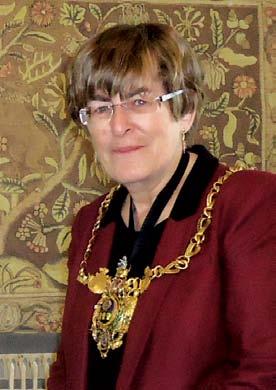
until she stepped down in May 2012. She said, “It was weird to see my name on posters in people’s windows; and then at each count, the piles of paper with a cross by my name – it’s very humbling that people place their faith in you.” Her particular interests have been planning, transport, culture, sport and the green environment. She was a member of Dr Sylvia Dunkley several committees, including the former South Yorkshire Transport Authority, had two very challenging but enjoyable years as Cabinet Member for Culture, Sport and Tourism, and chaired the City Centre Planning Board. She is very proud of successfully campaigning to reopen Ecclesall Library and supporting the transformation of Millhouses Park.
Reflecting on her decision to retire as a councillor after 17 years, Sylvia said,” It was time to do something different. It will be a big change for me but I’m planning to spend time researching my family history, and I will continue to support our family firm, Atomising Systems Ltd. I hope that the legacy of my year as Lord Mayor will be the continuing development of a Singing Strategy for local schools – I was particularly pleased to support the first Lord Mayor’s Singing Festival.”
Abhilash Sudarsanam takes part in the Lister Surgical Skills Competition 2012.
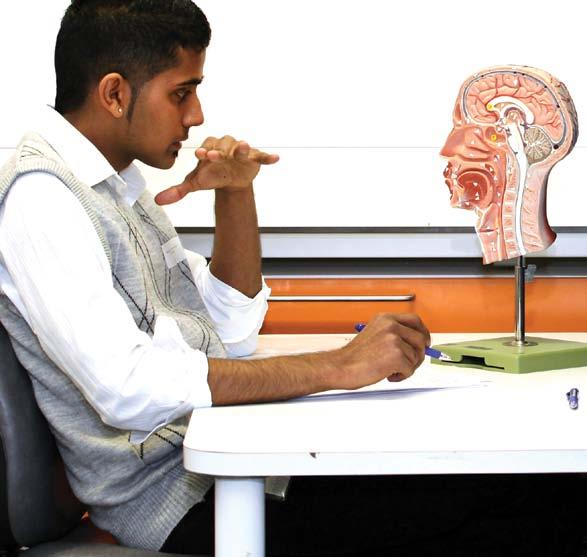
Surgical precision
Fourt h - year med ica l stude nt Abhilas h Sudarsa nam
put his expertise to the test in a UK-wide competition, organised by The Royal College of Surgeons of Edinburgh (RCSEd). He won one of 19 regional heats – competing against 18 students from the Universities of Hull, York, Leeds and Sheffield – and went on to represent Yorkshire and the Humber at the grand final of the Lister Surgical Skills Competition 2012. Clare McNaught, an RCSEd regional surgical adviser, said, “I was overwhelmed by the level of technical ability many of the students have already obtained, but particularly by Abhilash who was outstanding!”
“I’ve always wanted to be a surgeon,” Abhilash explained, “and I thought I’d give the competition a shot. The regional round was fairly straightforward with four surgical tests – knot tying, suturing, hand washing and surgical instrument identification. The final was more advanced, with disciplines such as tendon repair, anatomy, cross infection and laparoscopy. This was a good test as most of the finalists, including me, hadn’t done all of the disciplines before, though I had taken part in around 100 surgeries as part of my course. I found competing to be a truly rewarding and challenging experience.”
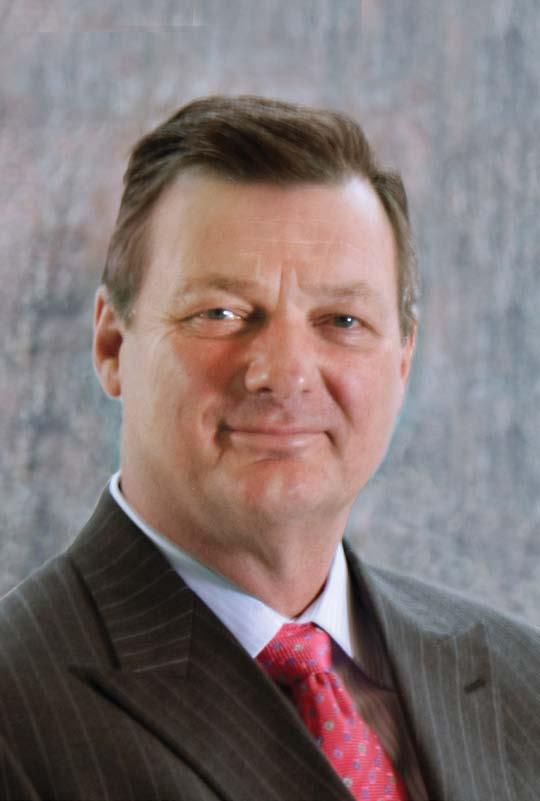
Fore ign member , Chinese
ASM Inter Adva nce
nat io nal Meda ment of Researc Acade my
l for t he h, 2011
Poto Nav
mac igator Inst itute Award
for , 2010 Po licy Stud ies
The Peo Fr iends ple’s Republic of hip Award , 2010 China
Elected Acade
a member of my of Engineer t he Nat io nal ing, 2005
Dr Jeffrey Wadsworth
Forged in Sheffield
The Univers ity ’s motto – To Discover t he Causes
of Things – is personified by Dr Jeffrey Wadsworth (BMet Metallurgy 1972, PhD Metallurgy 1975, DMet Metallurgy 1991, Hon DEng 2004). As President and Chief Executive Officer of Battelle Memorial Institute, located in Columbus, Ohio, he heads the world’s largest independent research and development company. “I have led this $6.5 billion enterprise through the worst recession in history,” he said, “and that has been challenging. But we did it. We continue to execute the mission of Battelle, which is to create new knowledge, turn it into inventions and products for societal good, make money doing so, and to reinvest that into further research and into education.”
Born in Germany, Jeffrey spent his early years in Holland, India, Singapore, Manchester, Aden and West Berlin as his father was in the army. He came back to the UK, to York, with his mother and brother when he was 16, following his father’s death. Jeffrey had a friend who lived in Sheffield, and that was one of the reasons why he chose to study at the University. He explained, “I had a chemistry teacher who told me I wouldn’t be good enough to study so-called pure sciences and suggested I apply for metallurgy or pharmacology. He gave me a book on metallurgy, Metals in the Service of Man, and that was about it. A lecturer at Sheffield called Gordon Richardson actually turned me on to the subject through his patience in teaching me; I became impassioned and wanted to go into research.”
He moved to the US in 1976: “Professor Greenwood in the Metallurgy Department gave me some contacts. One of them was Sheffield alumnus Professor Oleg Sherby (MMet Metallurgy 1957, DMet Metallurgy 1968) at Stanford University, who offered
of Engineer ing, 2012
me a one-year postdoc position. I was thrilled. I borrowed the money from Lloyds Bank, then on Glossop Road, for a one-way ticket to San Francisco and what I thought would be enough rent for three months in Palo Alto (it wasn’t).” Jeffrey’s career quickly evolved from research and development into executive roles. Following appointments at Stanford, Lockheed Missiles and Space Company, and the Lawrence Livermore National Laboratory, he assisted the White House in the establishment of the US Department of Homeland Security. He was the Director of Oak Ridge National Laboratory (2003–07) and oversaw Battelle’s Laboratory Operations as Executive Vice President (2007–08). He became the President of Battelle on 1 January 2009.
“Sheffield was an incredible experience for me,” he said. “What I learnt as an undergraduate served me in academia and industry for years and years. I was very lucky as I received full undergraduate and postgraduate scholarships. I laboured in the steel mills every summer and some winters and Easters and graduated with no debt, which is one of the reasons why I feel strongly about giving back.”
Jeffrey is a generous supporter of the University; one result is the Dr Jeffrey Wadsworth Scholarship for Medieval History. He said, “I think it is important to recognise those who helped you. I ended up doing a great deal of research on the ancient swords of Damascus, and then on other historical metals, and finally became interested in the carbon dating of steels and in particular the mystery of an iron plate found in the Great Pyramid of Giza. So maybe that is why the University chose to focus the scholarship on history. In any event, it sounds like a fun topic to study!” Going forward, half of Jeffrey’s support will go to Materials Science and Engineering – or, as he calls it, “the new metallurgy”.
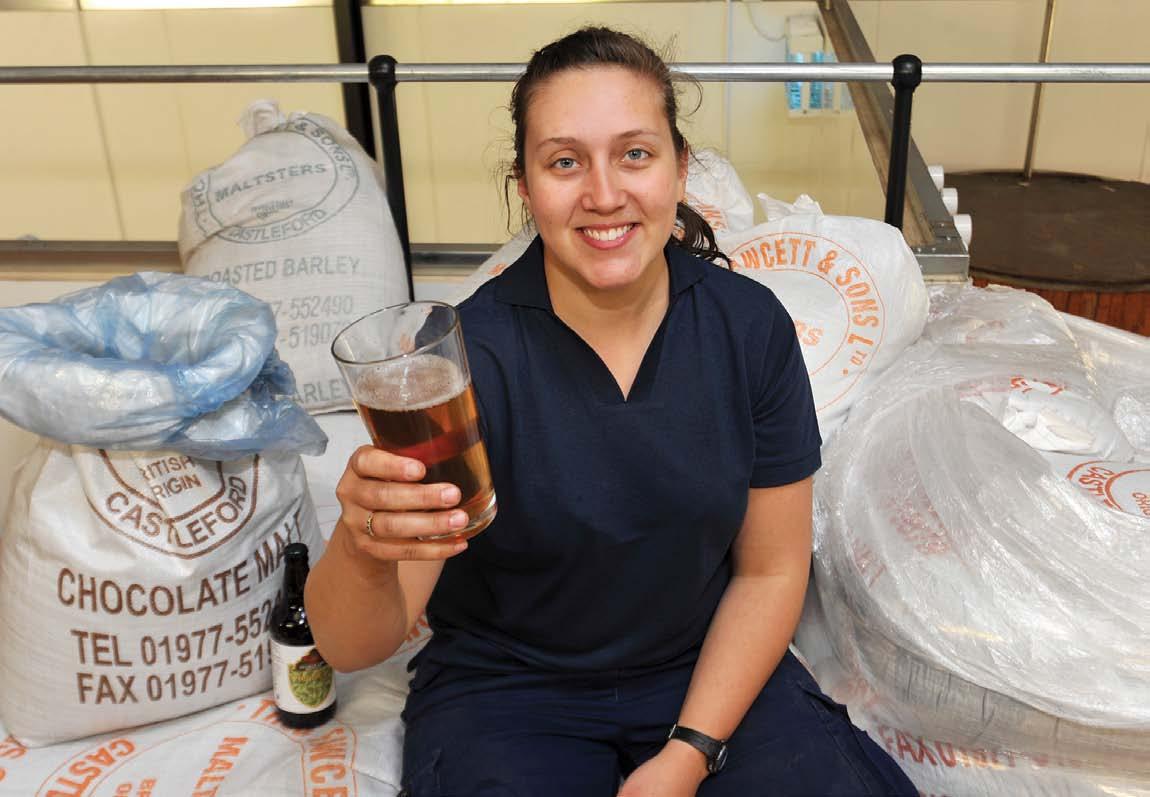
May your glass be ever full
Be ing in charge of your ow n brewery has to
be a dream come true for many beer lovers. Claire Monk (BSc Molecular Biology 2009) is living that dream as head brewer of Welbeck Abbey Brewery, located on the Welbeck Estate near Bolsover, Nottinghamshire. “I first got interested in yeast and fermentation during my degree,” she said, “and Professor David Hornby put me in touch with Dave Wickett [also see page 38] at Kelham Island Brewery in Sheffield. He ‘interviewed’ me in a pub and offered me a job. Six months later, I was head brewer at Welbeck – the brewery is jointly owned by Kelham Island and the Welbeck Estate.”
Claire was able to draw on her experiences as Activities Officer in the Students’ Union to get her started on the administrative, management and selling sides of the business: “When you are a sabbatical officer you are suddenly dropped in at the top level of a business and quickly get involved in budgets, accounts and business plans. That experience has been incredibly useful.”
Claire started at Welbeck just as the initial building work was underway. She oversaw the installation of the equipment and quickly got on with the first brews. There is a lot of competition in the world of micro-breweries nowadays and she has had to work hard to develop a list of customers. She supplies 100 pubs in Nottinghamshire, Lincolnshire and South Yorkshire, ten bottle beer shops and some wholesale outlets. She added, “There is just me and a driver on the staff at the moment and I brew twice a week. I would like to expand to four brews a week and cover a region that stretches to the coast and to Manchester. It’s great when a pub contacts me to start supplying Welbeck Abbey beer, following requests from their customers. I think my microbiology background means that I can brew to a consistent quality that the landlords appreciate.”
Follow Claire’s blog at http://welbeckabbeybrewery. blogspot.co.uk/ and visit Welbeck Abbey Brewery’s website at www.welbeckabbeybrewery.co.uk
Master microbrewing The Department of Molecular Biology and Biotechnology has launched an MSc in Microbrewing.
For details, visit www.sheffield. ac.uk/mbb/mscmicrobrewing
A mathematical inspiration
Co ming to Sheff ield as
an academic in 1961, Dr Mary Hart has experienced over 50 years of the life of the University. Although she officially retired in 2001, she has continued to teach part time, delivering one lecture course per semester. Simple numbers illustrate the scale of what she has witnessed – 3,000 students in 1961 and almost 26,000 in 2012. “My first single honours class numbered single figures; this had risen to about 15 by my second year. This year, I had a class of over 150 students on a third-year option,” Dr Mary Hart she said. “It was a more intimate atmosphere then. The campus was so much smaller – no Arts Tower, Concourse or University House, and trams ran along Western Bank. You weren’t quite teaching individually, but the small classes meant you knew how each student was coping with their work.” A graduate of Oxford University, Mary joined the Department of Pure Mathematics as they were waiting for the Hicks Building to be completed: “My office was in a very old house on Western Bank and you had to cross your fingers each time you walked in that one part of the ceiling wouldn’t give way!” The department moved into their new accommodation in 1962, with the first
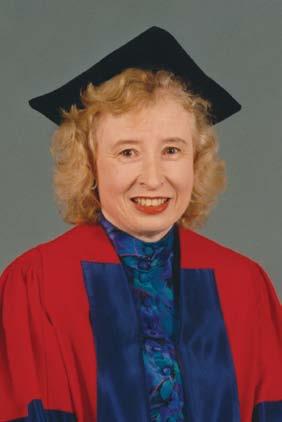
on-campus University computer installed on the top floor. Mary remembered, “Engineers had to come in twice a day (morning and evening) to run programmes to make sure that it was still working properly.”
Active in many aspects of University life, Mary has been a member of several committees, including the Pure Science Faculty Board, Senate, Council, Court, the Physical Planning Group and the Estates Committee. She was also Chair of the Advisory Group on Landscape and the Environment, and in this role she oversaw the production of an outline plan for the future development of the campus, including discussions on joining up St George’s with the Western Bank area. She chaired the working group that developed a room booking system across all departments – the precursor of today’s system. Mary was also Director of Undergraduate Affairs in the School of Mathematics and Statistics for several years before she ‘retired’.
Taking her pastoral role extremely seriously, Mary undertook counselling training, and her skills have been very useful in a School which, certainly during the earlier years of her career, had very few female members of staff. She cares about the welfare of her students and no doubt the feeling is mutual. She was very touched by their sympathy when her husband, Dr Robert Hart (MSc Mathematics 1961), sadly died suddenly in 2009: “Just after Robert died, one of my students was looking for information about postgraduate opportunities on Leeds University’s website, found Robert’s obituary and wrote a very kind letter. In view of this, it was decided to let all my students know. They keep a watch over me and I’ve been most impressed by their kindness and concern.”
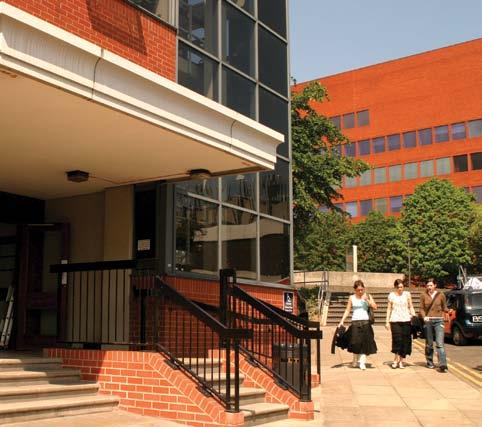
The Hicks Building, home to the School of Mathematics and Statistics.
A colleague’s view
Over her 50 years’ teaching in Sheffield, Mary Hart has been an inspiration to many generations of students, and her record of caring and selfless service to the University and the School has been an example to us all. When I arrived in Sheffield (a mere 22 years ago), Mary had already served what would now be considered an academic lifetime, and she was a respected source of tactful wisdom, someone who students turned to as a source of advice and comfort. It is a pleasure and a privilege to work with her.”
Professor John Greenlees, Head of the School of Mathematics and Statistics
Dr Tony Tan Keng Yam with his family on the occasion of the conferment of his honorary degree.
A sense of wonder
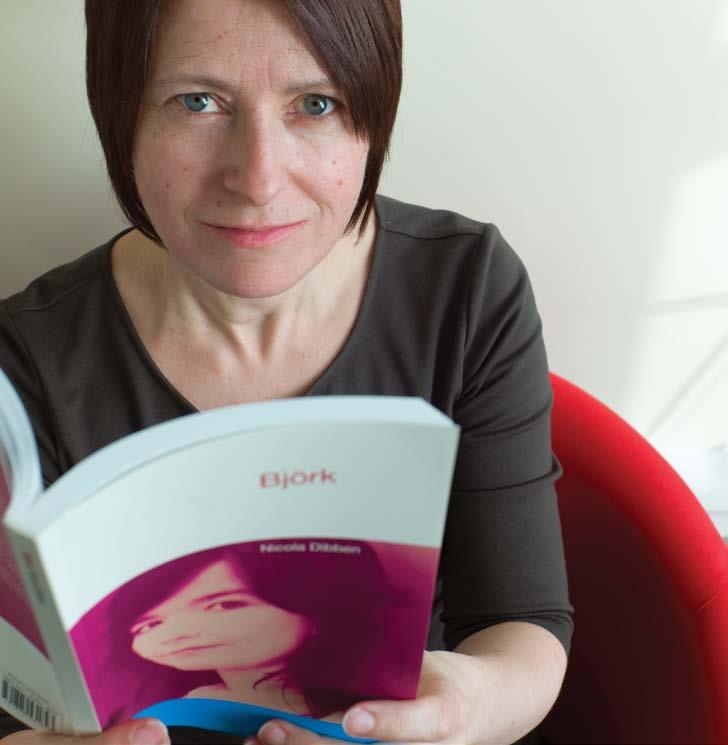
A ru n of luc ky co incide nces
brought Dr Nikki Dibben (PhD Music 1996, MEd Teaching and Learning for University Teachers 2004) into the centre of the strange and wonderful world of Icelandic recording artist Björk. A senior lecturer and the Director of Research in the Department of Music, Nikki specialises in the psychology of music and contemporary popular music. An initial interest in the representation of women in 1990s pop music – the Spice Girls, PJ Harvey, Gina G and Eurovision – led to a focus on Björk, one of the few female artists who have direct control over all aspects of their music.
“As a musicologist, I find Björk’s concepts and ideas fascinating,” Nikki said. “Her music reflects her interests in nature and technology – are these compatible interests or opposites? I began publishing articles on her work and these developed into a book, Björk, published in 2009, in which I reflected on the recurrent cultural themes brought into focus by her music. I interviewed several of her collaborators but failed to meet Björk herself. However, I sent a copy of the book to her management and received a call saying that Björk wanted me to work with her on her next project.” That turned out to be Biophilia, the ground-breaking album that was released in 2011 as a series of apps designed to run on smartphones and tablet computers.
Several meetings with Björk, in London, New York and Reykjavik, resulted in Nikki writing essays on the ten tracks, exploring the compositional and textual ideas behind the music, and these are available on the apps. She explained, “I analysed the lyrics and harmonic structures as well as the visual imagery. It was enlightening to have an insight into Björk’s creative processes and her fascination with multimedia. I would compare her to the director of a film as she worked with a team of 70 people to realise her vision.” Nikki’s role spread into other kinds of writing for Biophilia – press releases, a bid to a museum in New York to stage a live show – and she was also involved in workshops with school children, as part of the Manchester International Festival, and she interviewed Björk for a television documentary.
“It is very unusual for an academic to be involved in a project like this – to engage in the creative process,” said Nikki. “It has been a fascinating experience – and one that will continue for a while as I’m bringing my critical insight to Björk’s music again by contributing to her song book, which will present her composing and lyric writing in a multitude of ways.”
President of Singapore
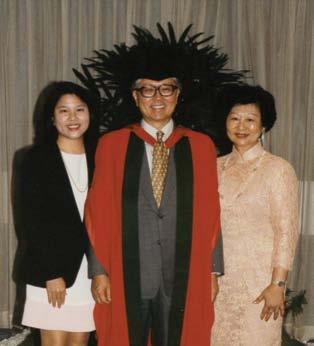
Singa pore ’s for mer de puty
prime minister Dr Tony Tan Keng Yam (Hon LLD 1998) won his country’s presidential election in August 2011. The University’s links with Singapore go back many years; our first known Singaporean graduate completed their studies in 1956. A special link was forged in 1979 when Lord Dainton, the University’s former Chancellor, advised the country on its higher education provision. On his recommendation, the University of Singapore and Nanyang University were merged to form the National University of Singapore – and President Tan became the new institution’s founding Vice-Chancellor (1980–81).
Pamela Liversidge OBE
Master Cutler 2011–12
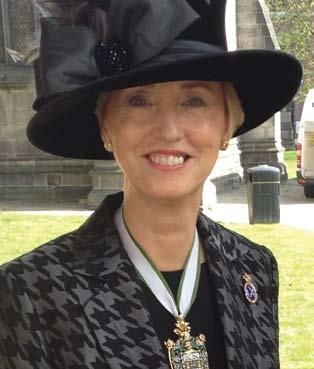
A chartered mec hanica l
engineer, Pamela Liversidge OBE (Hon DEng 2005) is the first woman to be appointed Master Cutler – the head of the Company of Cutlers in Hallamshire, established in 1624. Her husband, Doug Liversidge CBE (BMet Metallurgy 1958, Hon DEng 2001), held the same position in 1998–99. She was also the first woman to be appointed President of the Institution of Mechanical Engineers (1997–98). She is a Deputy Lieutenant and a former High Sheriff of South Yorkshire.

